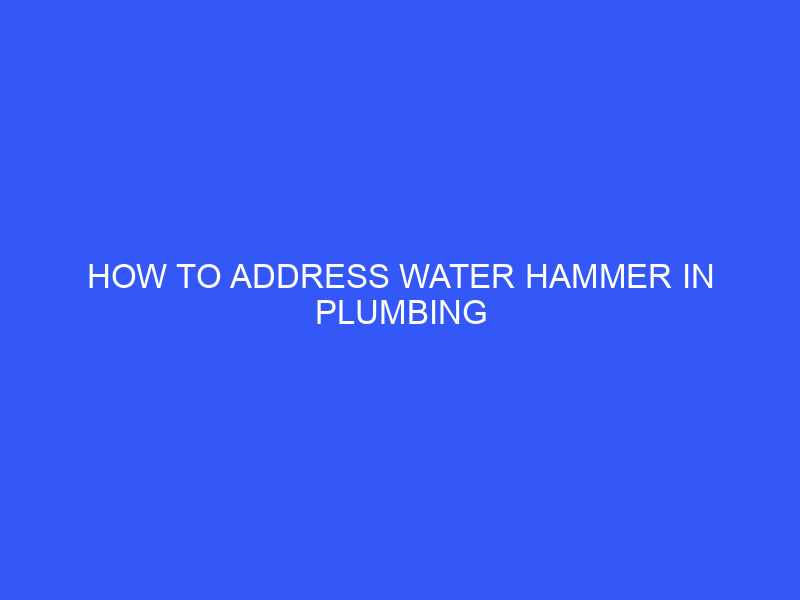It’s likely that at some point, you have heard loud pounding and knocking sounds coming from your pipes. Your plumbing system may experience high pressure due to fluid movements. Water hammer in plumbing is the outcome of a pressure spike and happens when valves that control the flow of liquids or steam close. When a high-pressure shockwave passes through a plumbing system, moving fluid will abruptly stop or alter its course.
How Water Hammer Is Triggered
A valve closing at the end of a pipeline is frequently the cause of the water hammer. Pump failure can also result in water hammer, but tilting disc, swing, and double door check valves tend to close quickly, producing high pressure. Since water is an incompressible liquid, a shock wave that travels at the speed of sound is produced when it collides with a closed valve. It will keep going until it reaches the next elbow in the pipeline or the pipeline’s end.
When a washing machine valve closes after the drum fills, a water hammer frequently happens in households. The water is still moving quickly. It bangs against the pipe’s side since it has nowhere else to go and may collide with adjacent lines or the wall frame.
Effect of Water Hammer on Plumbing Systems
Although a water hammer may only occur briefly, it can eventually damage or create an unexpected plumbing failure. It could result from leaky plumbing pipes or high water pressure in supply lines. Severe damage can occur to various fittings and connections and pumps, valves, expansion joints, gasketed joints, and welded joints. Possible outcomes include property damage, burst pipes, and water leaks.
How to Stop Water Hammer
You may do some actions to lessen the effects of water hammer in your home. Here are a few practical steps:
Drain the Air Chamber:
An air chamber is frequently used in residential plumbing systems to lessen the force of water when a valve closes. An air chamber is a space inside walls that can become wet. Draining your plumbing system can solve this by opening your home’s tallest faucet and shutting off the main water valve. Next, empty the lowest faucet’s water supply. The chamber should fill with air, solving your water hammer issue after draining the water.
Install a Water Hammer Arrestor:
An air-filled cylinder in this device helps to cushion the impact of sudden spikes in water pressure. Most water hammer arrestor installations use screw-type connectors between the supply line and the shut-off valve. Installing one arrestor on the hot water supply line and another on the cold is recommended.
Adjust the Water Pressure
The steps will only last for a while if your pipes have excessively high water pressure. The pressure-reducing valve, often found where your home’s main water supply enters, can be adjusted to control the pressure. If necessary, replace the valve by turning the handle or using a wrench or screwdriver. The recommended setting is less than 50 pounds per square inch (psi). Reducing the water pressure can help save water and energy while extending the life of plumbing fixtures.
Tighten Your Water Supply Lines
Fix the U-shaped straps to secure water pipes to studs or wooden joists. Lines may, therefore, move and produce noise. Tightening the screws and securing the loose pipe straps will solve the issue. It is also possible to add more belts to increase stability. The most common materials for pipe straps are thin metal or plastic; however, padded versions are also available to lessen vibration.
Insulate Water Supply Lines:
Insulation for foam pipes does more than keep lines from freezing. Additionally, you can use these tubes to cushion loose pipes. They are typically available in six-foot lengths and easily fit over your water supply line.
FAQ’S
What are air chambers, and how would they help prevent water hammer?
A water hammer is caused by shock waves partially absorbed by air chambers inserted in the water supply line. Avoid the loud water hammers’ pounding noises by placing appropriately sized air chambers close to fixtures and appliances.
Where should I install a water hammer arrestor?
Installing water hammer arrestors as close to trouble spots as you can when you hear water hammer pounding noises is advised. Appliances such as refrigerators, dishwashers, and washing machines can be installed on their supply lines.
How can I tell if a water hammer causes the noisy pipes in my home?
The telltale indicator of a water hammer is a loud bang or hammering sound coming from the pipes when you turn the water on or off. The sounds only appear when the water passing through the pipes changes.


